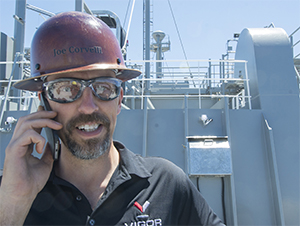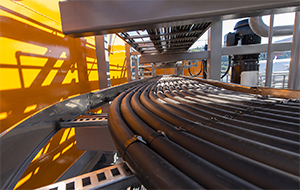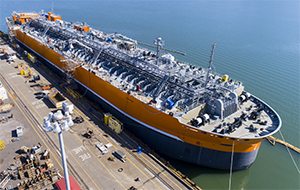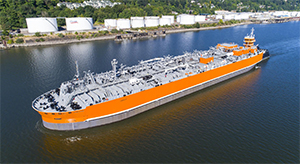Swan Island, in the Willamette River at Portland, Ore., saw a lot of ships launched from the Kaiser Yard during World War II, but those shipyard workers could not have imagined anything like the 508-foot Harvest launched by Vigor in 2017 from the same site. While the 1940s ships were primarily 526-foot tankers, any similarity with Harvest ends with the length.
The World War II ships were designed to carry oil while the technologically advanced Harvest — part of an articulated tug-barge (ATB) unit — carries liquid ammonia maintained at minus 27 degrees Fahrenheit. Commonly known as anhydrous ammonia, this chemical is used in a wide range of fertilizers. Classified as an extremely hazardous substance in the United States, an extensive array of features are required for its transport.
 |
|
Joseph Corvelli, senior vice president and program manager at Vigor, tends to business while giving a tour of Harvest at the shipbuilder’s facility on Swan Island in Portland. |
|
Alan Haig-Brown |
Harvest, the first barge of its type built to Jones Act standards since 1982, has met all of the safety requirements. Unlike oil barges that have large firefighting monitors mounted in pulpits, Harvest has an extensive water spray system over both the port and starboard cargo manifolds — the cargo is not flammable as much as it is hazardous. In the case of a leak, the water would quickly combine with the ammonia to neutralize it. Additionally, the manifolds have fail-safe valves to ensure a safe shutdown in an emergency. These valves are connected to the vessel control system to further enhance safe operations.
The four independent Type A prismatic cargo tanks are specially designed to carry the refrigerated cargo. To protect and insulate the tanks, which expand and contract with temperature change, they are mounted on a bed of specially fabricated wood. The tanks, with a total capacity of 22,000 tons, are carried in a double hull. Separate ballast tanks can be utilized when there is no cargo or only partial cargo aboard. In addition to accommodation ladders installed port and starboard, there are integral pilot ladders on both sides of the hull.
One of the challenges is maintaining the minus-27-degree temperature of the liquid cargo. To do this, the barge is equipped with dual redundant refrigeration units, electrically powered and overseen from the barge’s cargo control room (CCR). This computer center is replicated on the tug as well so that, especially at sea, barge operations such as reliquefaction through chilling can be carried out from the tug. The barge is also equipped to generate nitrogen to surround the cargo tanks.
 |
|
The barge’s cargo piping systems were fabricated and installed by Vigor subcontractor J.H. Kelly. |
|
Courtesy Vigor |
Harvest supplies The Mosaic Company, a leading producer of concentrated phosphate and potash, and is operated by a subsidiary of Savage Companies. The complexity of the barge was apparent in a dockside walk-through in Portland. Various components called for specialized suppliers and subcontractors, and the involvement of well-established marine component supplier Wartsila was evident throughout. Vigor subcontractor J.H. Kelly, based in Longview, Wash., was a key partner, providing the onboard electrical work and cargo piping systems.
Four 940-kW generator sets are each powered by a Caterpillar C32 diesel. An additional 163-kW genset provides hotel power when in port. Among the demands that can be met by the nearly 4 megawatts of capability is providing power for a 2,000-hp Schottel pump-jet bow thruster. The thruster is similar to those used on European inland river cargo ships and barges but is three times more powerful. Thrusting energy can be directed over 360 degrees and controlled via umbilical from the tug.
 |
|
Harvest, shown docked in Portland, Ore., can carry 22,000 tons of anhydrous ammonia chilled to minus 27 degrees Fahrenheit. Dual redundant refrigeration units keep the temperature in check. |
|
Courtesy Vigor |
Two other significant consumers of power on the new barge are the twin redundant ballast water treatment systems. Developed by Norway-based Optimarin, they employ a combination of filtration and 35-kW ultraviolet lamps to treat ballast water without the need for chemicals. Ballast water is treated both when taken on and when discharged. The classification society DNV GL tested the system to U.S. Coast Guard standards for fresh, brackish and marine water.
Harvest is mated to the 139-by-44-foot Abundance. Built by Nichols Brothers Boat Builders Inc. in Freeland, Wash., the 8,000-hp tug is powered by a pair of EMD 16-710T13 main engines. Articouple Inc. supplied the coupling system for the ATB. The hydraulically controlled pins can allow a change in draft of the barge while only partially disconnected from the tug. Ocean Tug and Barge Engineering of Milford, Mass., provided the concept design while Seattle-based Glosten provided the functional design.

